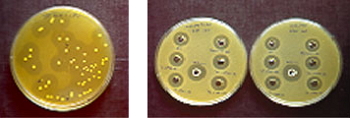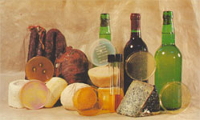LACTIC BACTERIA PRODUCING BACTERIOCINS
|
Description |
In our research group we are working on the biochemical, immunological and genetic characterization of bacteriocins produced by lactic acid bacteria (LAB) from food origin. In addition to evaluate the bacteriocinogenic potential of lactic bacteria naturally isolated from food, we are proceeding to the genetic modification of lactic acid bacteria in order to express vaious bacteriocins and, thus, facilitate their use as starter cultures, protective cultures and as LAB producers of bacteriocins as probiotic bacteria in food, human and medical applications, in animal production and for the aquaculture.

Lactic acid bacteria and antimicrobial activity of their bacteriocins.
|
How does it work |
Bacteriocins are microbial peptides of small size, with a very potent antimicrobial activity against zoonotic bacteria and those responsible of foodborne diseases in man. They are resistant to heat and are hydrolyzed by gastric proteinases, which facilitates their possible use as natural food preservatives.
On the other hand, natural or genetically modified lactic acid bacteria producing bacteriocins could be used in the preparation of nutraceutical or functional foods, and as probiotics in animal feed, which would reduce the presence of spoiling and pathogenic microorganisms and potentiate in the animals the development of a competitive intestinal flora against the growth of many pathogens.
|
Advantages |

Foods susceptible for improvement of their quality by treatment with bacteriocins.
- The use of naturally occurring or genetically modified lactic bacteria (GMOs) producing several bacteriocins would permit their use as starter cultures, but also as protective cultures in many foods.
- The incorporation of these bacteriocin-producing bacteria into food would eliminate or reduce the use of synthetic chemical additives.
- Because bacteriocins are resistant to heat, acidity, low wt, etc., they can be used to increase the safety and shelf life of many foods, as well as their use as natural antimicrobial additives made by microorganisms considered safe in food.
- Lactic acid bacteria producing bacteriocins could also be used as probiotics in animal feed.
|
Where has it been developed |
This technology has been developed in the Department of Nutrition, Bromatology and Food Technology of the Faculty of Veterinary Medicine of the Universidad Complutense de Madrid. This department already has an experience of more than 10 years in the biochemical, immunological and genetic characterization of bacteriocins produced by lactic acid bacteria of food origin.
The bacteriocins characterized up to now are nisin A, nisin Z, pediocin PA-1, lactocin S, enterocin A, enterocin B, enterocin P, enterocin L50A and enterocin L50B, enterocin JSA and enterocin JSB, and enterocin HF. Currently we also have genetically modified L. lactis strains (OGM's) producing nisin A, pediocin PA-1, enterocin P and enterocin A.
|
And also |
As a developing technology, these biological substances are still under evaluation and subject to legislation regulating their use. However, our research group can provide the experience and know-how to initiate "in vitro" studies as well as of the use of techniques for scaling up and evaluation of their effectiveness in real situations, all of them aimed to evaluate the potential of bacteriocins as natural food preservatives. We also consider ourselves prepared to address the use of lactic acid bacteria producing bacteriocins as probiotics in animal feed, not only from farm animals but also from the continental and marine aquaculture.
|
Contact |
|
© Office for the Transfer of Research Results – UCM |
|
PDF Downloads |
|
Classification |
|
Responsible Researcher |
Pablo E. Hernández Cruza: ehernan@vet.ucm.es
Department: Nutrition, Bromatology and Food Technology
Faculty: Veterinary Medicine


